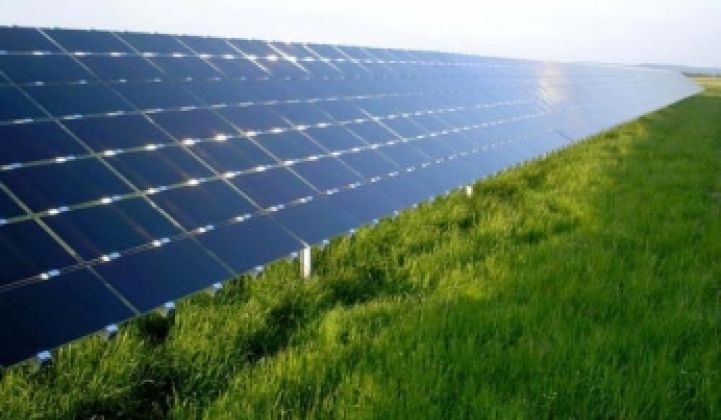Sunworks Solar, formed just last August, is aiming to build a solar panel manufacturing business and market it products with a "buy American" pitch.
The San Francisco startup is in the midst of negotiating with New York officials over an inventive package to build a factory in the state, said Brian Robertson, co-founder and CEO of Sunworks, on Thursday.
Just earlier this week, the New York Power Authority (NYPA) agreed to allocate 5 megawatts of hydropower to support the construction and operation of a $200 million factory for Sunworks.
The approval would be part of the package that could lure the solar panel maker to New York, though whether the company would build a factory there will depend on the terms of the whole incentive package, Robertson said.
Robertson said the offer from the state is attractive so far, and he expects the negotiation to conclude over the next two to three months.
The $200 million would finance the construction and outfitting a factory with equipment for a 75-megawatt-per-year production line, he added. He declined to discuss the financing for the factory plan.
The NYPA's announcement shone a spotlight on Sunworks when the company was hoping to remain quiet. Robertson co-founded the company after serving as president of SunEdison, a well-known solar project developer that has won contracts from utilities such as Duke Energy and Xcel Energy.
Sunworks' two other co-founders are Guy Blanchard and Chris Cook, according to the company website. Blanchard was a managing director of Fortress Investment Group's Drawbridge funds.
Cook was SunEdison's senior vice president of regulatory affairs and a current board member of the Interstate Renewable Energy Council, a Latham, N.Y.-based nonprofit that does renewable energy education and outreach.
The three founders started Sunworks last summer after surveying the U.S. market and found that there were may solar panel factories in the country. They believe selling U.S.-made solar panels would be an attractive proposition for the growing number of utilities and businesses that install solar energy systems.
"California spends hundreds of millions of dollars a year on solar power program, and most of that money is going to Chinese and European manufacturers," Robertson said. "We think it's a strong story for state legislatures and utility regulators to create a lot of end demand for solar in the U.S. but not having all those dollars going to China."
Sunworks has settled on amorphous silicon solar technology for its factories because it promises to deliver inexpensive solar panels to drive down the installation costs, Robertson said.
The company plans to buy factory equipment from either Applied Materials in Santa Clara, Calif., or Oerlikon Solar in Switzerland. Robertson said a purchasing decision would be made in a few months. The equipment would produce panels with two layers of active ingredients for converting sunlight into electricity: amorphous silicon and microcrystalline silicon.
Sunworks picked thin film over crystalline silicon solar panel manufacturing because thin-film manufacturing is a more streamlined process, he said.
Crystalline silicon panels are made of solar cells, which are produced by using silicon wafers. Wafers come processed ingots, which are made by using silicon. There are companies that supply only one of the components in the whole process, though many provide two or more.
Thin-film manufacturing, on the other hand, doesn't require that many types of suppliers. The equipment is set up to take in raw materials from one end and churn out panels at other end.
"When I was at SunEdison and a buyer of different PV modules, I found that the crystalline silicon supply chain had so many steps that the contracts you thought you could depend on would go away or the price would go away," Robertson said. "With thin films, you don't have to worry about wafer suppliers facing delays or cell providers not getting the certification on time."
Although amorphous silicon technology holds a lot of promise for delivering cheap solar electricity, it has also no shortage of critics. Many amorphous silicon solar panel makers worldwide have only begun mass production in the past year, and the panels produced so far have much lower efficiencies (less than 10 percent) than crystalline silicon solar panels, best of which are close to 20 percent.
Amorphous silicon panels also can't compete in efficiencies with the biggest thin-film solar panel maker in the world, Tempe, Ariz.-based First Solar, which uses cadmium-telluride instead.
The one high-profile power project in the United States that was going to be built with amorphous silicon panels died when the project developer and panel maker, Hayward, Calif.-based OptiSolar, couldn't come up with the financing to keep the business going. It sold the project development business to First Solar earlier this year (see Inside OptiSolar's Grand Ambition).
Robertson is unfazed. He and his co-founders plan to build more factories in the United States, though he declined to discuss them. He also declined to talk about Sunworks' investors.
If Sunworks decides on building a factory in New York, it would start construction in early 2010 and complete it in 2011. The company wouldn't limit the factory to 75 megawatts – the target is to build two production lines (150 megawatts) for each factory, Robertson said.
Join experts and influencers at Greentech Media's Growth Opportunities in the New PV Market: Projects, Finance and Policy in San Francisco on July 13.




